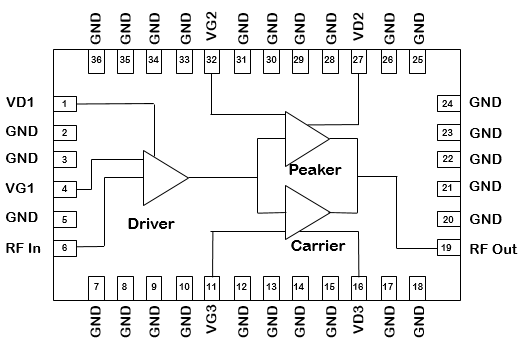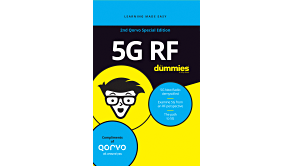Power Amplifier Modules and Their Role in 5G Design
August 26, 2022
This post first appeared on the Mouser Electronics website.
5G is one of the most important and powerful technologies ever to reach the market in the field of wireless communications. Offering significant improvements in data rates, latency and capacity as compared to 4G, 5G is poised to be a truly transformative technology in the industry and the world.
Yet, these radical performance improvements generate increased strain on and tighter requirements for the underlying radio frequency (RF) hardware. One of the most instrumental pieces of RF hardware is the power amplifier (PA), a device whose importance has only increased with the proliferation of 5G. To help ease the challenges of designing RF PAs for 5G, power amplifier modules (PAMs) have become an important tool in recent years.
In this post, we'll talk about PAs, their role in 5G, and how Qorvo leverages PAMs to help support the 5G infrastructure of the future.

What Is a PA?
When working with RF signals, especially at the higher frequency bands of 5G, voltage levels can be extremely low. This is a challenge because the electromagnetic (EM) signal becomes more susceptible at lower amplitudes to the effects of system-level noise (i.e., signal-to-noise ratio decreases). On top of this, lower-voltage signals generally lack the strength necessary to drive downstream circuitry or antennas.
To address these challenges, engineers use PAs. An RF PA is a circuit block that serves to increase the amplitude, power output, or drive capacity of an RF signal. Generally, RF PAs live near the system antennas to provide a transmitting antenna with a high-power signal.
With a PA, the goal is to boost the signal while maintaining a high level of fidelity from input to output. For these reasons, linearity, efficiency and output power are important specifications for a PA.
PA Design Challenges
Historically, PAs and their surrounding circuitry were designed using discrete components on a board. While this approach has served the industry for many years, the efficacy of this approach is coming into question as several nontrivial design challenges emerge.
One of these challenges is being able to balance the tradeoffs among area, cost, performance and power consumption. Generally, these specifications tend to conflict with one another, and designers must know how to optimize their circuits to balance the tradeoffs in an optimal way for their given application. Balancing these tradeoffs is increasingly difficult when using discrete components as considerations like part selection, component interoperability, and layout impact performance.
This is further confounded when moving to 5G, where systems need to cover wider bandwidths and higher frequency ranges. Today's systems require an average instantaneous bandwidth of up to 400 MHz while operating at frequencies up to 4 GHz. The challenge is now maintaining the aforementioned system tradeoffs while also providing performance over this frequency band.
Download your free copy of our e-book.
You'll Learn:
- See the 5G vision today and in our future
- Understand 5G New Radio architecture and rollout
- Understand the 5G drivers and use cases
- Which innovative RF front-end solutions are enabling 5G
- Discover the path to 5G and key milestones to look for
Solutions with a PAM
To address these challenges, Qorvo has turned to PAMs.
A PAM is an electronic component that integrates the discrete components in a PA, and its surrounding circuitry, into a single packaged solution. For example, in the application of a 5G base station, a PAM might integrate the driver amplifier and final stage amplifier into a single package as opposed to implementing them as discrete circuit blocks. By integrating the entire PA system onto a single module, we can achieve many important results (Figure 1).

Figure 1: The Qorvo QPA4501 PAM incorporates a Doherty final stage for high power and efficiency.
First, PAMs make the design of RF systems, such as base stations, significantly easier than the discrete option. Instead of selecting components and designing a discrete circuit, designers can instead select a module that fits their needs and implement it within their system as a whole.
Beyond this, PAMs can offer improved performance and area when compared to non-module solutions. By integrating the components, layout concerns, such as parasitics, can be minimized, resulting in higher performance and efficiency. Qorvo PAMs also address considerations like impedance matching for the designer, ensuring that maximum performance is attainable.
Lastly, this integration allows for smaller systems on average, saving weight and area for users in their final system design.
Qorvo's PAM Expertise
Qorvo offers the industry's largest, most innovative GaN-on-SiC portfolio to help users realize superior efficiency and operational bandwidth. The GaN-on-SiC products deliver high power density, reduced size, excellent gain, high reliability and process maturity. Qorvo recognizes the importance of PAMs in the future of 5G system designs and is working to bring industry-leading solutions to the market. Qorvo's PAMs aim to offer a balance of power, efficiency, size and cost while making the design as easy as possible for the users.
Have another topic that you would like Qorvo experts to cover? Email your suggestions to the Qorvo Blog team and it could be featured in an upcoming post. Please include your contact information in the body of the email.

